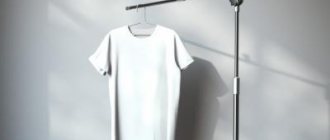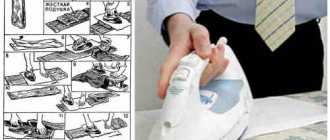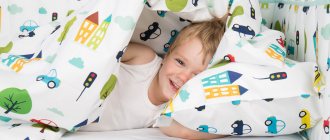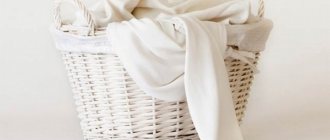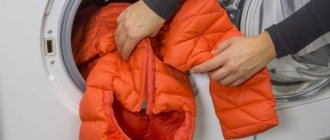Not all housewives manage to perfectly iron clothes with sleeves and small details. While you iron your sleeve, the front or back of your blouse may wrinkle. And sometimes it turns out even worse - in the most visible place of your favorite dress, the fabric suddenly shrinks or a hole with scorch marks appears. To prevent this from happening, it is necessary to perform this seemingly well-known action in a strictly defined sequence, observing a number of rules. We'll tell you how experienced housewives do it and their secrets of working with an iron.
How to iron things you need every day
There are several ways to iron clothes:
- Dry, when the item is simply ironed on the front and back sides.
- With extra moisture. In this case, the item of clothing is first sprayed with water or kept for a certain time under a wet towel.
- With steaming. Suitable for smoothing out creases and folds. To do this, you need an iron with this function or a special steam generator.
During the ironing process, do not stretch the material.
Skirt and pants
For a skirt, first iron the top, waistband, and pockets. Then you need to iron the seams, the area with the zipper, the main part and finally the bottom of the product. You can iron things made of thick fabric using a steam generator, carefully so that the material does not stretch.
The trousers begin to be ironed from the inside out, carefully working the seams and pockets, moving towards the top of the product, pressing firmly on the iron at the edges.
The crotch seams of the trousers are ironed first, and then the side seams. To preserve the arrows, you can rub them from the inside with a bar of dry soap, and iron them from the face through a cloth soaked in a vinegar solution. At the end, the belt is ironed.
Shirt, dress
Before ironing, the iron must be well heated and the shirt fabric must be moistened. Iron starting from the collar, working it on both sides, then iron the cuffs and sleeves (on an auxiliary board). At the end, the floors and back are smoothed, close attention is paid to buttons and openings.
Dresses are ironed on the top first, then the hem. Vertical darts should be ironed towards the center, and chest darts should be ironed towards the bottom. The product is ironed first across and then lengthwise. During the process, be sure to straighten out all the wrinkles on the item with the tip of the iron.
Jeans
Denim items should be ironed not completely dry, turned inside out. A bulky piece of fabric is placed in the pockets to prevent them from imprinting. Afterwards they are ironed from the face from the waist, going down.
If your knees are sagging, you need to sprinkle them with water from the inside and then iron them from the outside.
Uniform, jacket
Classic suits should be ironed with damp gauze placed on top to eliminate shine. Blazers and cardigans are first ironed from the sleeves to the sides. You can hang the suit over a hot bath to let it hang loose. Ironed items are immediately hung on hangers.
Tie
Before ironing, the product should be slightly moistened by wrapping it in a wet towel. Do not spray water from a spray bottle on it. You need to iron it through gauze, moving in one direction from the place where the knot was. To prevent the seam mark from being visible from the back, you can cut out an insert template that follows the shape of the tie, which will prevent prints from appearing on the outside of the item.
Clothes and diapers for babies
Many people don’t know how to quickly iron things for infants. It is better to iron slightly damp items so as not to spray them with a spray bottle. If the iron is equipped with a steam function, this step is skipped. You need to iron things from the back, because it is the back that comes into contact with the baby’s skin.
After ironing, clothes should cool down to avoid the greenhouse effect on the closet shelf.
Workplace organization
Before you get started, it's worth spending a little time on some preliminary preparation. This will save time and effort in the future.
- The surface of the ironing board should approximately be located at a height equal to the distance from the person’s elbow to the floor. Using smooth and multi-stage height adjustment, you can find a comfortable level for yourself. If you can adjust the position of the board, you can iron things not while standing, but while sitting on a sofa or chair.
- The soleplate of the iron and the steam chamber must be clean. The reservoir should be filled with filtered or boiled water.
- The work surface should be well lit. During the day, the board can be placed closer to the window.
- A stationary work place significantly saves time using folding and retractable boards, which do not need to be moved to the work area from the place of permanent storage each time.
- It is more convenient to use a large ironing board.
- The socket, if it is not built into the ironing board, should be conveniently located, and the cord should not interfere with operation.
- It is advisable to have a place where to put already ironed items and where to place a hot iron.
- The work surface must be safe and stable.
- The cover on the board should be soft, firmly and securely fastened, and not move when ironing along with the fabric. It's inconvenient, constantly distracting and slows down your work.
- Before starting work, clothes must be sorted into separate piles depending on the recommended ironing temperature. This way you won’t have to constantly change the temperature and switch the thermostat.
- It is advisable to prepare clothes hangers in advance.
- To prevent ironing from seeming so monotonous and tedious, you can do it while listening to music or in front of the TV.
If there is a lot of laundry, but, on the contrary, there is very little time, you can compromise and come to an agreement with yourself - first of all, iron the things that are needed. Everything else can be put aside for a while or you can skip this stage of caring for clothes altogether - carefully roll everything up after drying and put it in the closet.
How to iron linen and home textiles
It is better to iron bamboo, linen and cotton items a little damp. When there are decorative inserts, use gauze. Here are some useful tips:
- The sheets have elastic. The linen is folded in half, then in half again, then ironed. It is necessary to ensure that there are no folds or creases on the product. You can iron in another way: start from the center, gradually turning the fabric itself, moving in a circle. But it’s easiest to iron it directly stretched on the mattress.
- Duvet covers. First, all buttons and zippers are fastened, the product is straightened and ironed on one side. Then fold it in half so that the wrinkled side remains on the outside and iron it. And so on until the duvet cover takes the desired size for storage.
- Silk bedding. Many people do not know how to iron silk bed linen: they iron it half-dry, only from the inside out.
- Tablecloths. If they are trimmed, ironing starts from the edge and ends in the middle. It is better to fold a regular tablecloth 4 times and iron it one by one on all sides.
- Curtains. The easiest way to iron them is by vertical steaming using a steam generator. If there is none, chairs are placed around the ironing board to lay the ironed fabric. Iron the curtain from above, moving downwards.
Secrets of ironing warm clothes
It is not recommended to wash winter clothes; it is better to go to dry cleaning. But if washing and ironing cannot be avoided, you need to know the material from which the item is made.
Coat
If it is made of wool, it is ironed while not completely dry on the back side at a maximum temperature of 100°C. All seams are carefully ironed. The collar, lapels, as well as the outside are ironed through a wet fabric. For a drape coat, you can use steam, only the back of the product is placed on a soft surface.
Cloak
Leather products can only be ironed through additional fabric at the lowest temperature without steam. You can hold the item over a bath of hot water. Suede raincoats that cannot be ironed are also ironed. Cotton outerwear is ironed on both sides, including the lining.
If the item is made of polyester, you should iron it starting at a low temperature, gradually increasing it.
Bolognese jacket
It is necessary to iron it from the wrong side, placing a piece of damp gauze. You can use an iron with a steam function. After the jacket is turned inside out, the procedure is repeated. Before ironing, it is necessary to check the material for resistance to high temperatures.
Which iron to choose
In any home appliance store there are many options for the mentioned device. A large assortment makes it much more difficult for an inexperienced person to find the ideal solution. A few recommendations below will help you decide on the best option.
Irons with Teflon-coated soles are the cheapest. In operation, they performed well, but they have one significant drawback - they are easily scratched by metal fittings.
Ceramic soles are not afraid of damage. Devices equipped with them glide well over fabric, straighten it easily and are easy to clean. It is this option that is ultimately more profitable to take.
The next parameter is the steam generator. The more powerful it is, the better. It is desirable that the iron can work in a vertical position. With such an assistant you will be able to iron things without removing them from their hangers.
The presence of a built-in spray bottle is welcome, but not required. The fact is that the volume of its tank does not last long.
If your wardrobe contains a lot of items made from delicate fabrics, then look for a model that has a special attachment for the sole. With it, the iron will not damage thin materials.
A good option has at least 5 heating modes. You shouldn’t limit yourself to less, and you simply don’t need more.
Important: make sure that the cord of the device is long enough - this will make ironing much more convenient.
Special cases
Often there are elements on clothes that are difficult to iron. Proven methods come to the rescue.
Lantern sleeve
A damp towel is placed inside and folded into a ball to get as close to the size of the flashlight as possible. Use a hot iron to smooth out all wrinkles. You can use a steam generator that can handle any creases. If you don’t have either one or the other at hand, a hairdryer will come to the rescue, just pre-wet the fabric. She is blown with hot air.
Folds and pleats
The product is laid out on an ironing board, each fold is straightened out. A damp cloth is placed on top, and the iron is set to the appropriate temperature for the material. You need to iron every fold. When using special crease removers, iron from the inside out.
The top of the item can be treated with a vinegar solution so that it does not wrinkle for a long time.
Embroidery
The easiest way is to steam a washed item. If you don't have a steamer, you can do this with an iron on low heat. To maintain volume, ironing should be done on a soft surface from the back. When you have to iron from the front side, gauze is applied to the embroidery. Silk threads are ironed dry, beads are only steamed.
Lace
Such products should be ironed with starch. The lace is ironed with care, all folds are smoothed out with the tip of the iron. Openwork cotton clothes are ironed from the back through wet gauze, but ironing silk clothes is not recommended.
About the ironing board
The first thing you should pay attention to is the size of the working surface. At a minimum, it should be enough to freely accommodate the trousers. It is not advisable to take shorter options. The short length of the board does not help in any way to save free space in the apartment, because it folds up.
The next parameter is ease of use. The ironing attribute in question must:
- be light and yet stable;
- adjustable in height;
- get ready quickly.
You also need to make sure that the model you choose is equipped with a removable softening cover, armrest and iron stand. A built-in socket would also be useful.
Rules for ironing items made from different fabrics
What material the product is made from is indicated on the inside label. It may also contain information about the permitted temperature for ironing.
- Cotton and linen. The laundry needs to be slightly wet. This will speed up the ironing process and improve the effect. Linen fabric is ironed at 190-230°C, cotton fabric - 160-190°C on the back side to avoid shine.
- Wool. Woolen wardrobe items should be ironed with a gauze on the back side, as they are very stretchy. It is better to just apply the iron or simply steam the item. The ideal temperature is 140-165°C.
- Satin, silk and synthetics. These are delicate materials that cannot withstand high temperatures. If the mode is incorrectly selected, they melt. It is ideal to use lining fabric. It is better to iron silk after moistening it. Just don’t spray it, as water stains will remain on the material. To moisturize, wrap the item in a wet towel for about half an hour. Dark silk is ironed with a dry iron through a thin fabric from the back, and light silk from the face. The temperature varies between 115-140°C. Satin is ironed in much the same way as silk, using the same setting.
- Corduroy and velvet. It is recommended not to iron these materials. Even a light touch with a hot iron will damage the product and crush the material. To straighten the folds, just hold the item of clothing over boiling water or pass along it with a steam generator. There is a more gentle mode: for this you will need a soft lining, which is covered with a towel. A product made of velvet or corduroy is placed on top with the wrong side up. This way you can protect the pile from damage. The material is ironed at low temperature. There is no need to press the iron. If the item still has sunken spots, they can be removed by holding the item face down over hot steam.
- Knitwear. After washing, this material often loses its shape. As a result, it is better to iron knitted items while the back side is still damp. The iron should be applied to the product, and not actively driven. The ironed item does not need to be folded immediately. It’s better to lay it out on the bed and let it dry completely.
- Viscose. Ironed at a temperature of 90-115°C only after the product has completely dried. This should be done from the back to prevent damage to the clothes. Before ironing, the item of clothing is laid out on a board, leveled, and the seams are folded one on top of the other. If you hold the iron in one place, the fabric may lose texture and color.
- Organza and chiffon. Extremely delicate fabrics. Chiffon should be ironed at 60°C. If the iron does not provide such a mode, ironing is carried out through gauze or a clean paper sheet, which prevents heating of the material. Chiffon should not be steamed or sprayed as this will leave noticeable stains on the material. The fabric is moistened with a damp towel. Organza is ironed on thick material through paper or a piece of gauze. The temperature is the same as for chiffon - low to avoid yellow spots.
- Nylon. The material cannot be ironed as it can be damaged at any temperature. To remove wrinkles, the product is moistened in the bathroom and laid out to dry.
- Fabrics with pile. You can use the steamer without pressure. Faux fur with long pile is also steamed, but only through gauze. Then it is combed in the direction of the pile.
What will help with ironing
In addition to the iron, you may additionally need:
- Gauze is a protective material for ironing synthetic fabrics. Dark items are ironed through gauze, which may begin to shine if they come into contact with a hot surface.
- Special mesh for ironing clothes - improved gauze. Withstands temperatures up to 200°C, perfectly transmits steam and heat, prevents things from shining.
- Vinegar. It is necessary so that there is no shine on things.
- If complex creases on silk clothes cannot be ironed, you can use a glycerin solution (10 g per 5 liters of water). The item is rinsed in the resulting composition, wrapped in a dry towel, dried, and ironed. Glycerin makes it easier to smooth out wrinkles on clothes.
The steam generator will help smooth out even deep wrinkles in dry clothes. Also, ironing is simplified by an ironing system with a board that has the functions of supercharging and retaining heat.
How to choose an ironing board
An ironing board is a convenient device that greatly facilitates the process of ironing clothes. If it is chosen correctly. When choosing, take into account:
- Product weight. This is especially important if a woman will use the board. Lightweight products are preferable.
- The strength of the structure is not at the expense of lightness, but it should not wobble on its legs or bend under pressure comparable to the pressure of a hand with an iron.
- Compactness - a folding board should not be bulky and convenient for storage.
- Comfortable to use. The optimal width is sufficient for quick ironing and the presence of additional elements: an iron stand, hangers or shelves for ironed items, a carrier with fasteners for a socket to turn on the iron plug, an additional narrow board for ironing sleeves and cuffs.
- The quality of the coating should be moderately soft and non-stick.
- Mobility - a device with simple height adjustment to suit a person’s height and reliable fixation is required.
The most important part of an ironing board is the tabletop. There are three preferred materials for their manufacture:
- Mesh (woven, metal);
- A solid metal sheet (optimally covered with wood), but such a tabletop should have enough holes for steam to escape so that the cover lasts longer;
- Thermoplastic is an innovative development for ironing boards from the German company Leifheit. It does not deform, reflects heat, releases steam well - but this is the most expensive option.
Important! Designs with chipboard countertops can only be considered as a temporary option. These products are inexpensive, but also short-lived: due to humidity and steam, the plywood will inevitably deform and the board will “lead.”
Now you know how to iron things correctly.
This means that the process will not cause previous difficulties and unpleasant emotions. So, ironing clothes and ordinary things is not at all as complicated and time-consuming a process as it seems. But the ability to do this quickly and efficiently is acquired exclusively with practice!
How to iron without an iron
If ironing is prohibited or there is no iron nearby, you can resort to the following methods:
- A kind of vertical steamer. Clothes are hung over a basin or bathtub filled with boiling water for 20-30 minutes.
- Hot mug. Boiling water is poured into the container to heat it up, and the item is ironed.
- Wet towel. This method is suitable for ironing sweaters and woolen pullovers. The clothes are laid out on a damp terry towel and straightened out. After a few hours, the folds become even, after which the wardrobe items are hung on hangers.
- A special solution of 9% vinegar, water and fabric softener mixed in equal proportions. The mixture is poured into a spray bottle and sprayed onto the crumpled products. After drying there are no creases left.
- Roll. To prevent wardrobe items from becoming wrinkled, it is better to roll them up rather than fold them into squares.
- Wet palm. Shallow folds are smoothed out with a hand dipped in water.
You can also try using a hot tablespoon to smooth out wrinkles, but only on natural fabrics. Wet materials can be smoothed with a hairdryer.
Why iron things
An iron is an essential tool for disinfecting things from germs, especially if a person suffers from skin diseases. The same goes for things for newborns. In the first months of life, children's immunity is very weak and needs to be protected from bacteria. Ironing also breaks down detergent residues that can cause allergies. Ironing items relieves discomfort - the seams soften and do not rub the skin.
Regular ironing preserves the original properties of the fabric and extends the service life of clothing. The products become more neat, and as a result, the entire appearance.


